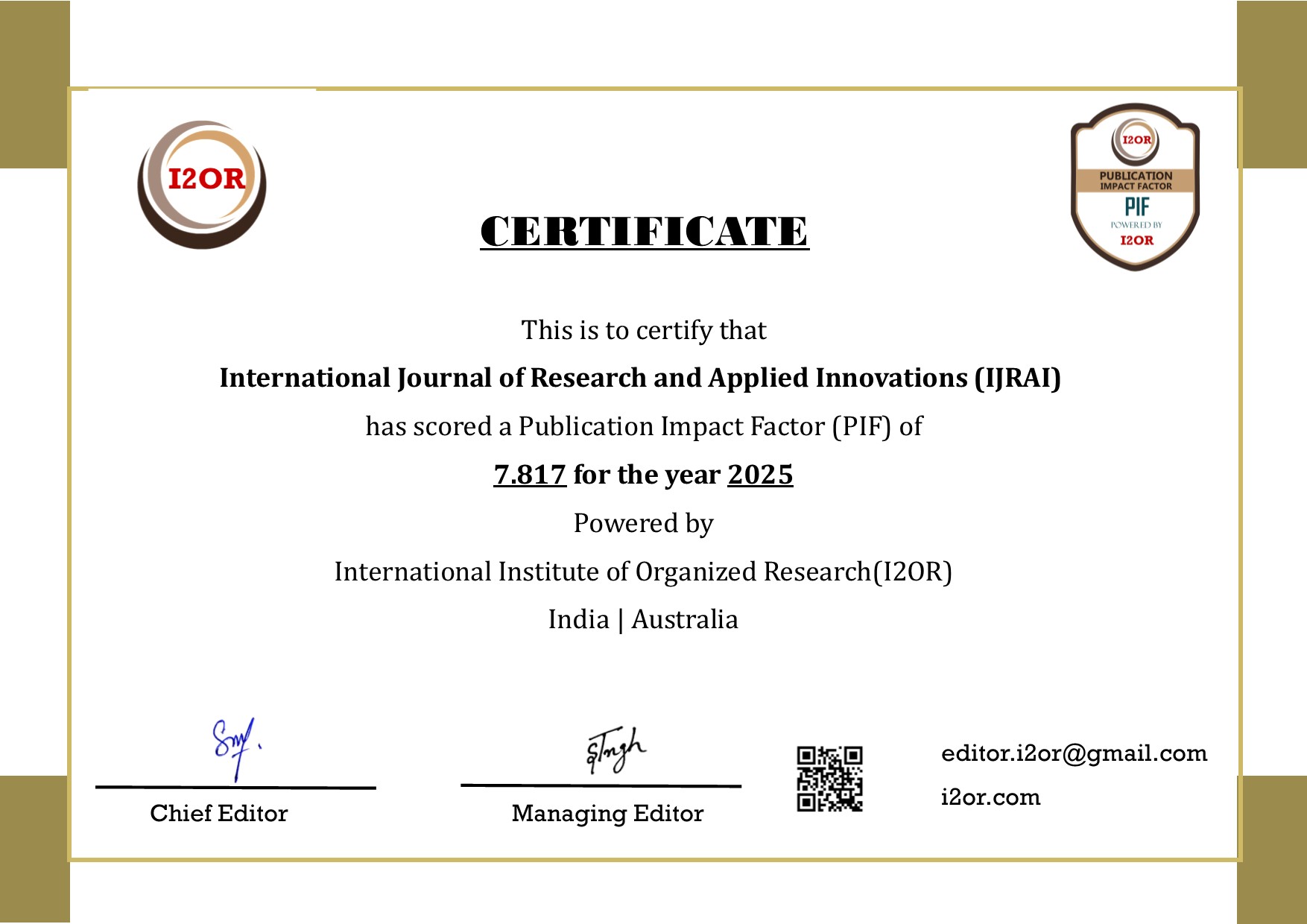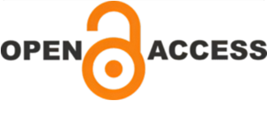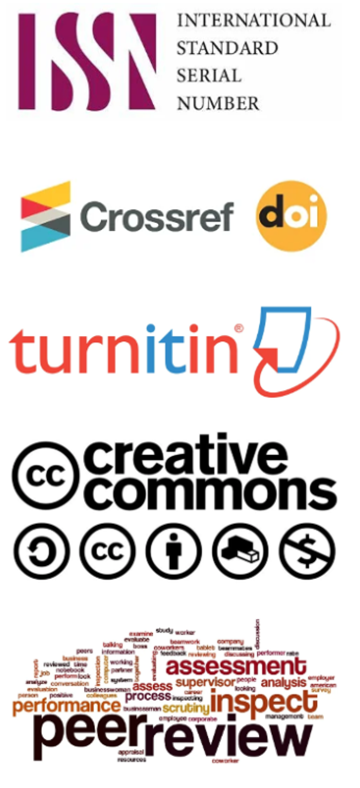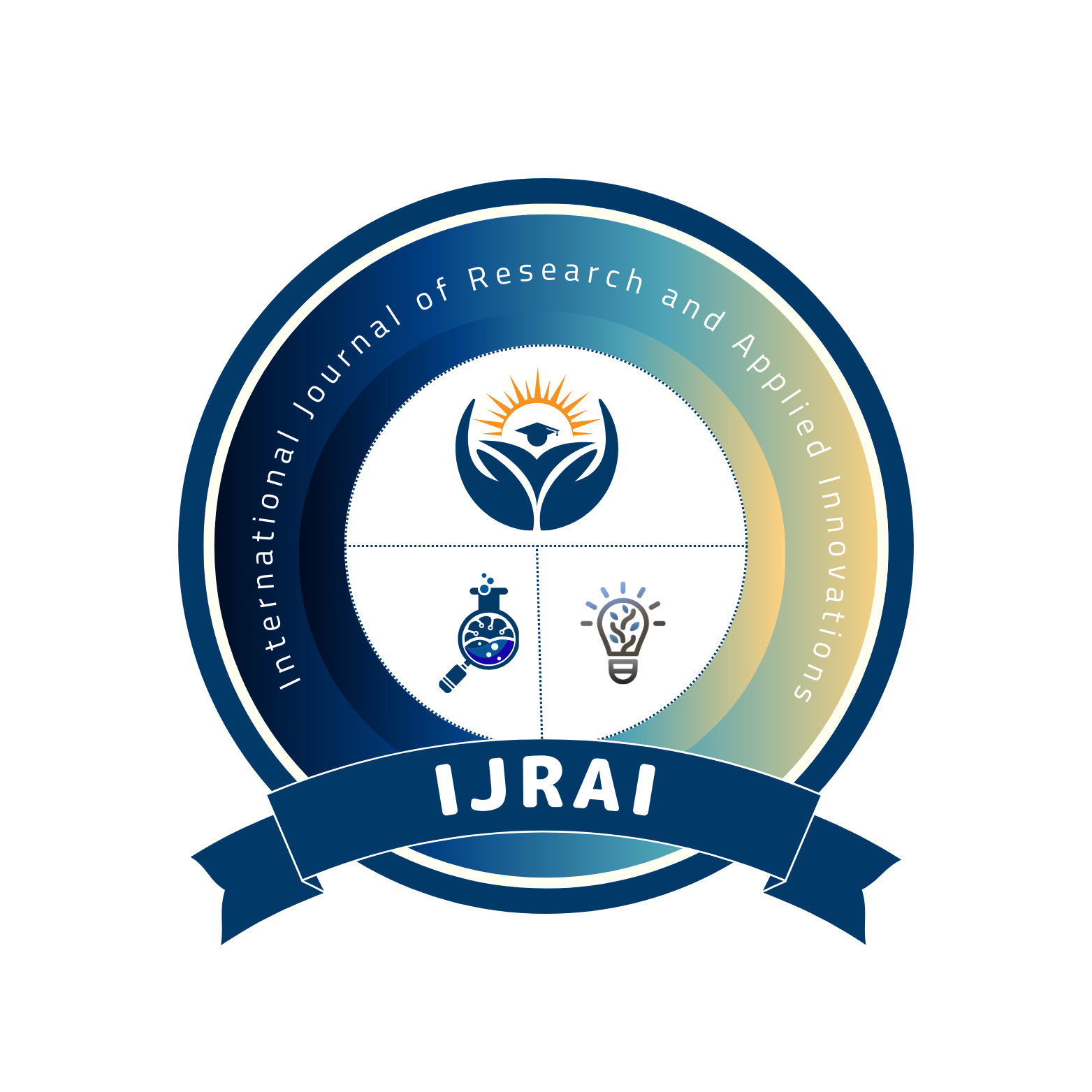Quantum-Resistant AI Security: Preparing for the Post-Quantum Era
DOI:
https://doi.org/10.15662/IJRAI.2025.0805007Keywords:
AI security, quantum computing, post-quantum cryptography, intrusion detection, machine learning, encryption protocolsAbstract
Quantum computing is a major breakthrough in processing capabilities and can break the established cryptographic systems, which are based on the hard mathematical problems, including RSA and ECC. The security of such systems (that hold sensitive data around the world) is currently at risk like never before due to the ability of quantum algorithms such as the Shor algorithm to efficiently factor large numbers and compromise the current encryption. This has necessitated the urgency of quantum-resistant security protocols. The key to this change is the Artificial Intelligence (AI) which offers more adaptive and intelligent solutions, capable of developing and optimizing encryption techniques that can resist quantum-based attacks. The fact that AI is capable of examining large volumes of data, identifying weak points and creating defense mechanisms in real-time makes it a key instrument in securing digital infrastructures in the post-quantum era. This paper discusses the potential of AI in enhancing the creation of potent security mechanisms, and this would be used to guarantee integrity, confidentiality, and stability of digital systems in a quantum computing revolutionized future.
References
[1] Azmi, S. K. (2025). Enhancing Java Virtual Machine Performance for Scalable Artificial Intelligence and Machine Learning Workloads. Well Testing Journal, 34(S3), 566-580.
[2] Syed Khundmir Azmi. (2025). Enhancing Java Virtual Machine Performance for Scalable Artificial Intelligence and Machine Learning Workloads. Well Testing Journal, 34(S3), 566–580. Retrieved from https://welltestingjournal.com/index.php/WT/article/view/221
[3] Azmi, S. K. (2025). Enhancing Java Virtual Machine performance for scalable artificial intelligence and machine learning workloads. Well Testing Journal, 34(S3), 566–580.0
[4] Azmi, S. K. (2025). LLM-Aware Static Analysis: Adapting Program Analysis to Mixed Human/AI Codebases at Scale. Global Journal of Engineering and Technology Advances, 24(03), 260-269.
[5] Syed, Khundmir Azmi. (2025). LLM-Aware Static Analysis: Adapting Program Analysis to Mixed Human/AI Codebases at Scale. Global Journal of Engineering and Technology Advances. 24. 10.30574/gjeta.2025.24.3.0284.
[6] Azmi, S. K. (2025). LLM-aware static analysis: Adapting program analysis to mixed human/AI codebases at scale. Global Journal of Engineering and Technology Advances, 24(3), 260–269.
[7] Azmi, Syed Khundmir. “LLM-Aware Static Analysis: Adapting Program Analysis to Mixed Human/AI Codebases at Scale.” Global Journal of Engineering and Technology Advances, vol. 24, no. 3, 30 Sept. 2025, pp. 260–269, https://doi.org/10.30574/gjeta.2025.24.3.0284. Accessed 7 Oct. 2025.
[8] Azmi, S. K. (2023). Trust but Verify: Benchmarks for Hallucination, Vulnerability, and Style Drift in AI-Generated Code Reviews. Well Testing Journal, 32(1), 76-90.
[9] Syed Khundmir Azmi. (2023). Trust but Verify: Benchmarks for Hallucination, Vulnerability, and Style Drift in AI-Generated Code Reviews. Well Testing Journal, 32(1), 76–90. Retrieved from https://welltestingjournal.com/index.php/WT/article/view/229
[10] Azmi, S. K. (2023, February 6). Trust but verify: Benchmarks for hallucination, vulnerability, and style drift in AI-generated code reviews. Well Testing Journal, 32(1), 76–90.
[11] Syed, Khundmir Azmi. (2023). Secure DevOps with AI-Enhanced Monitoring. International Journal of Science and Research Archive. 9. 10.30574/ijsra.2023.9.2.0569.
[12] Syed, Khundmir Azmi. “Secure DevOps with AI-Enhanced Monitoring.” International Journal of Science and Research Archive, vol. 9, no. 2, 30 June 2023, pp. 1193–1200, https://doi.org/10.30574/ijsra.2023.9.2.0569. Accessed 13 Oct. 2025.
[13] Azmi, S. K. (2022). From Assistants to Agents: Evaluating Autonomous LLM Agents in Real-World DevOps Pipeline. Well Testing Journal, 31(2), 118-133.
[14] Azmi, S. K. (2022). From assistants to agents: Evaluating autonomous LLM agents in real-world DevOps pipeline. Well Testing Journal, 31(2), 118–133.
[15] Syed Khundmir Azmi. (2022). From Assistants to Agents: Evaluating Autonomous LLM Agents in Real-World DevOps Pipeline. Well Testing Journal, 31(2), 118–133. Retrieved from https://welltestingjournal.com/index.php/WT/article/view/230
[16] Azmi, S. K. (2022). Green CI/CD: Carbon-Aware Build & Test Scheduling for Large Monorepos. Well Testing Journal, 31(1), 199-213.
[17] Syed Khundmir Azmi. (2022). Green CI/CD: Carbon-Aware Build & Test Scheduling for Large Monorepos. Well Testing Journal, 31(1), 199–213. Retrieved from https://welltestingjournal.com/index.php/WT/article/view/231
[18] Azmi, S. K. (2022). Green CI/CD: Carbon-aware build & test scheduling for large monorepos. Well Testing Journal, 31(1), 199–213.
[19] Azmi, S. K. (2021). Computational Yoshino-Ori Folding for Secure Code Isolation in Serverless It Architectures. Well Testing Journal, 30(2), 81-95.
[20] Azmi, S. K. (2021, October 28). Computational Yoshino-Ori folding for secure code isolation in serverless IT architectures. Well Testing Journal, 30(2), 81–95.
[21] Syed Khundmir Azmi. (2021). Computational Yoshino-Ori Folding for Secure Code Isolation in Serverless It Architectures. Well Testing Journal, 30(2), 81–95. Retrieved from https://welltestingjournal.com/index.php/WT/article/view/237
[22] Azmi, S. K. (2021). Riemannian Flow Analysis for Secure Software Dependency Resolution in Microservices Architectures. Well Testing Journal, 30(2), 66-80.
[23] Azmi, S. K. (2021). Riemannian flow analysis for secure software dependency resolution in microservices architectures. Well Testing Journal, 30(2), 66–80.
[24] Syed Khundmir Azmi. (2021). Riemannian Flow Analysis for Secure Software Dependency Resolution in Microservices Architectures. Well Testing Journal, 30(2), 66–80. Retrieved from https://welltestingjournal.com/index.php/WT/article/view/236
[25] Azmi, S. K. (2025). Voronoi partitioning for secure zone isolation in software-defined cyber perimeters. Global Journal of Engineering and Technology Advances, 24(03), 431-441.
[26] Azmi, S. K. (2025). Voronoi partitioning for secure zone isolation in software-defined cyber perimeters. Global Journal of Engineering and Technology Advances, 24(3), 431–441
[27] Syed, Khundmir Azmi. (2025). Voronoi partitioning for secure zone isolation in software-defined cyber perimeters. Global Journal of Engineering and Technology Advances. 24. 431-441. 10.30574/gjeta.2025.24.3.0294.
[28] Azmi, Syed Khundmir. “Voronoi Partitioning for Secure Zone Isolation in Software-Defined Cyber Perimeters.” Global Journal of Engineering and Technology Advances, vol. 24, no. 3, 30 Sept. 2025, pp. 431–441, https://doi.org/10.30574/gjeta.2025.24.3.0294. Accessed 13 Oct. 2025.
[29] Syed, Khundmir Azmi. (2025). Zero-Trust Architectures Integrated With Blockchain For Secure Multi-Party Computation In Decentralized Finance. INTERNATIONAL JOURNAL OF CREATIVE RESEARCH THOUGHTS. 13. 2320-2882
[30] Syed, Khundmir Azmi. (2025). Bott-Cher Cohomology For Modeling Secure Software Update Cascades In Iot Networks. INTERNATIONAL JOURNAL OF CREATIVE RESEARCH THOUGHTS. 13. g1-g12.
[31] Azmi, S. K. (2025). Bott-Cher Cohomology for Modeling Secure Software Update Cascades in IoT Networks. International Journal of Creative Research Thoughts (IJCRT), 13(9)
[32] Syed, Khundmir Azmi. (2025). Retrieval-Augmented Requirements: Using RAG To Elicit, Trace, And Validate Requirements From Enterprise Knowledge Bases.
[33] Azmi, S. K. (2025, September 9). Retrieval-Augmented Requirements: Using RAG to Elicit, Trace, and Validate Requirements from Enterprise Knowledge Bases. International Journal of Creative Research Thoughts (IJCRT), 13(9).
[34] Syed, Khundmir Azmi. (2025). Hypergraph-Based Data Sharding for Scalable Blockchain Storage in Enterprise IT Systems. Journal of Emerging Technologies and Innovative Research. 12. g475-g487.
[35] Azmi, S. K. (2025). Kirigami-Inspired Data Sharding for Secure Distributed Data Processing in Cloud Environments. JETIR, 12(4).
[36] Syed, Khundmir Azmi. (2025). Kirigami-Inspired Data Sharding for Secure Distributed Data Processing in Cloud Environments. Journal of Emerging Technologies and Innovative Research. 12. o78-o91.
[37] Syed, Khundmir Azmi. (2024). Human-in-the-Loop Pair Programming with AI: A Multi-Org Field Study across Seniority Levels. International Journal of Innovative Research in Science Engineering and Technology. 13. 20896-20905. 10.15680/IJIRSET.2024.1312210|.
[38] Azmi, S. K. (2024, October). Klein bottle-inspired network segmentation for untraceable data flows in secure IT systems. IRE Journals. https://www.irejournals.com/formatedpaper/1711014.pdf
[39] Syed, Khundmir Azmi & Azmi,. (2024). Klein Bottle-Inspired Network Segmentation for Untraceable Data Flows in Secure IT Systems. 8. 852-862.
[40] Syed, Khundmir Azmi & Azmi,. (2023). Quantum Zeno Effect for Secure Randomization in Software Cryptographic Primitives. 7. 2456-8880.
[41] Azmi, S. K. (2024, March). Quantum Zeno effect for secure randomization in software cryptographic primitives. IRE Journals. Retrieved from https://www.irejournals.com/paper-details/1711015
[42] Azmi, S. K. (2024). Cryptographic hashing beyond SHA: Designing collision-resistant, quantum-resilient hash functions. International Journal of Science and Research Archive, 12(2), 3119–3127.
[43] Syed, Khundmir Azmi. (2024). Cryptographic Hashing Beyond SHA: Designing collision-resistant, quantum-resilient hash functions. International Journal of Science and Research Archive. 13. 3119-3127. 10.30574/ijsra.2024.12.2.1238.
[44] Azmi, Syed Khundmir. “Cryptographic Hashing beyond SHA: Designing Collision-Resistant, Quantum-Resilient Hash Functions.” International Journal of Science and Research Archive, vol. 12, no. 2, 31 July 2024, pp. 3119–3127, https://doi.org/10.30574/ijsra.2024.12.2.1238. Accessed 9 Oct. 2025.
[45] Syed Khundmir Azmi. (2023). Photonic Reservior Computing or Real-Time Malware Detection in Encrypted Network Traffic. Well Testing Journal, 32(2), 207–223. Retrieved from https://welltestingjournal.com/index.php/WT/article/view/244
[46] Azmi, S. K. (2023, August 31). Photonic reservoir computing or real-time malware detection in encrypted network traffic. Well Testing Journal, 32(2), 207–223.
[47] Azmi, S. K. (2023). Photonic Reservior Computing or Real-Time Malware Detection in Encrypted Network Traffic. Well Testing Journal, 32(2), 207-223.
[48] Syed, Khundmir Azmi. (2025). Algebraic geometry in cryptography: Secure post-quantum schemes using isogenies and elliptic curves. International Journal of Science and Research Archive. 10. 1509-1517. 10.30574/ijsra.2023.10.2.0965.
[49] Azmi, Syed Khundmir. “Algebraic Geometry in Cryptography: Secure Post-Quantum Schemes Using Isogenies and Elliptic Curves.” International Journal of Science and Research Archive, vol. 10, no. 2, 31 Dec. 2023, pp. 1509–1517, https://doi.org/10.30574/ijsra.2023.10.2.0965. Accessed 15 Oct. 2025.
[50] Azmi, S. K. (2023). Algebraic geometry in cryptography: Secure post-quantum schemes using isogenies and elliptic curves. IJSRA. https://ijsra.net/sites/default/files/IJSRA-2023-0965.pdf
[51] Syed, Khundmir Azmi. (2022). Bayesian Nonparametrics in Computer Science: Scalable Inference for Dynamic, Unbounded, and Streaming Data. 5. 399-407.
[52] Azmi, S. K. (2022, April). Bayesian nonparametrics in computer science: Scalable inference for dynamic, unbounded, and streaming data. IRE Journals. https://www.irejournals.com/formatedpaper/1711044.pdf
[53] Syed Khundmir Azmi. (2022). Computational Knot Theory for Deadlock-Free Process Scheduling in Distributed IT Systems. Well Testing Journal, 31(1), 224–239. Retrieved from https://welltestingjournal.com/index.php/WT/article/view/243
[54] Azmi, S. K. (2022, March 30). Computational knot theory for deadlock-free process scheduling in distributed IT systems. Well Testing Journal, 31(1), 224–239.
[55] Azmi, S. K. (2021, September). Markov Decision Processes with Formal Verification: Mathematical Guarantees for Safe Reinforcement Learning. IRE Journals, 5(3) https://www.irejournals.com/formatedpaper/1711043.pdf
[56] Syed, Khundmir Azmi. (2021). Markov Decision Processes with Formal Verification: Mathematical Guarantees for Safe Reinforcement Learning. 5. 418-428.
[57] Ahmadi, A. (2023). Quantum Computing and Artificial Intelligence: The Synergy of Two Revolutionary Technologies. Asian Journal of Electrical Sciences, 12(2), 15–27. https://doi.org/10.51983/ajes-2023.12.2.4118
[58] Ansari, M. F., Dash, B., Sharma, P., & Yathiraju, N. (2022, September 1). The Impact and Limitations of Artificial Intelligence in Cybersecurity: A Literature Review. Papers.ssrn.com. https://papers.ssrn.com/sol3/papers.cfm?abstract_id=4323317
[59] Dixit, S. (2020). The Impact of Quantum Supremacy on Cryptography: Implications for Secure Financial Transactions. Philpapers.org. https://philpapers.org/rec/SACTIO-8
[60] H. A. Bhat, F. A. Khanday, B. K. Kaushik, F. Bashir, and K. A. Shah, "Quantum Computing: Fundamentals, Implementations and Applications," in IEEE Open Journal of Nanotechnology, vol. 3, pp. 61-77, 2022, doi: 10.1109/OJNANO.2022.3178545.
[61] Kumar, M., & Pattnaik, P. (2020). Post Quantum Cryptography (PQC) - An Overview: (Invited Paper), 2020 IEEE High Performance Extreme Computing Conference (HPEC), Waltham, MA, USA, 2020, pp. 1-9, doi: 10.1109/HPEC43674.2020.9286147.
[62] Mavroeidis, V., Vishi, K., D., M., & Jøsang, A. (2018). The Impact of Quantum Computing on Present Cryptography. International Journal of Advanced Computer Science and Applications, 9(3). https://doi.org/10.14569/ijacsa.2018.090354
[63] Radanliev, P., David, D. R., & Santos, O. (2023). Red Teaming Generative AI/NLP, the BB84 Quantum Cryptography Protocol and the NIST-Approved Quantum-Resistant Cryptographic Algorithms. ArXiv.org. https://arxiv.org/abs/2310.04425
[64] Sharma, S., Ramkumar, K. R., Kaur, A., Hasija, T., Mittal, S., & Singh, B. (2023). Post-quantum Cryptography: A Solution to the Challenges of Classical Encryption Algorithms. Modern Electronics Devices and Communication Systems, 23–38. https://doi.org/10.1007/978-981-19-6383-4_3
[65] Vo, H. V., Du, H. P., & Nguyen, H. N. (2023). AI-Powered Intrusion Detection in Large-Scale Traffic Networks Based on Flow Sensing Strategy and Parallel Deep Analysis. Journal of Network and Computer Applications, 220, 103735. https://doi.org/10.1016/j.jnca.2023.103735
[66] Yavuz, A. A., Nouma, S. E., Hoang, T., Earl, D., & Packard, S. (2022). Distributed Cyber-infrastructures and Artificial Intelligence in Hybrid Post-Quantum Era, 2022 IEEE 4th International Conference on Trust, Privacy and Security in Intelligent Systems, and Applications (TPS-ISA), Atlanta, GA, USA, 2022, pp. 29-38, doi: 10.1109/TPS-ISA56441.2022.00014.









